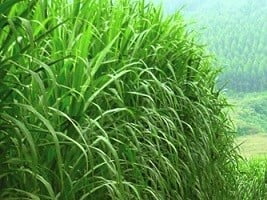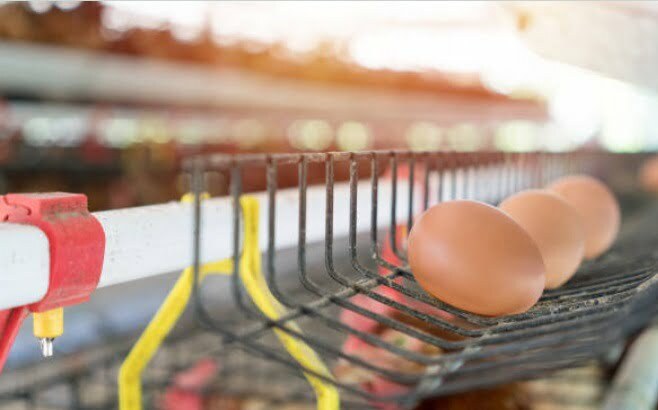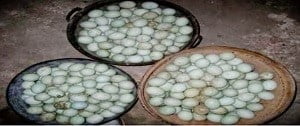King grass, the best alternative?
Another type of grass that is very good for use as forage is the king’s grass. This king grass, its Latin name is Pennisetum purpureum x Pennisetum thypoides.
Why is the name so long? That’s because this grass is the result of a cross between the elephant grass (Pennisetum purpureum) and the bare grass (Pennisetum thypoides).
His name is then combined. Thus, eventually his latin name became Pennisetum purpupoides.
This king grass is better than elephant grass. Better in terms of the number of forage production and in terms of nutritional content.
In my previous article, about elephant grass, elephant grass forage production is 2.21 kg / m2.
2.21 kg / m2 was the production of elephant grass once harvest. So, if made in hectares, the productivity is 22,100 kg / hectare or 22.1 ton / ha / once harvest.
If in a year harvested 12 times, then per year, the production of forage grass elephant is as much as 265.2 tons / hectare / year. This if the harvest every 30 days. This harvest distance I have made very close once.
When compared with the king’s grass, the productivity of this elephant grass is far away. This is because the productivity of the king’s grass can be up to 1,076 tons / ha / year. [1]
Nutrition of grass king grass vs elephant grass
The nutritional content of king grass is slightly higher than elephant grass. For example, the crude protein content of elephant grass is about 9%. You can see in my previous article. While the crude protein of the king grass is about 11%.
The nutritional content of king grass is crude protein 11,68%, Crude Fiber 25,48, Ca 0,37% and P 0,39%. However, there is another source which states its value is slightly different.
The difference is that the content of the king grass has 19.94% dry matter, 12.23% crude protein and 88.83% organic matter.
Why is this value different? This is natural, because the nutrient content of a grass is affected by several factors.
Especially forage, such as elephant grass, odot grass and king grass, harvesting age, soil conditions, planting methods and fertilization doses greatly affect the value of nutritional content.
If we get information about the nutritional value of a feed ingredient, we can not make it a definite value. Therefore, the value of a nutrient is affected by the process and the way it is calculated.
The safest step is to think of it as an approximate number.
To simplify I will give a table that provides information on the comparison of nutritional content of elephant grass and king grass.
If the information about the nutritional content is incomplete, while that is the only information I can gather. If later I find the complementary data, I will add later.
How to plant king grass
This king grass is similar in character to sugarcane. If you know how to cutted sugarcane, then you know how to plant this kind of grass.
The stem to be used as a seed is the middle part. This is to avoid seeds with too young or too old age because the growth is not optimal.
Good stem size is between 1.5 – 2 cm. One stem cuttings usually consists of 2-3 buds.
No need to exfoliate the leaves in the stem. This is to help the water content of the seeds not evaporate quickly. Especially if the planting in the dry season.
The normal range between seeds is 1 m x 1 m. So, if per 1 hectare seeds needed as many as 10 thousand seeds of king grass.
This king grass is a type of plant that needs high enough water. So need a strategy in planting it.
Paddy fields, the need for water may not be so an issue. However, it is different for land with rain-fed water systems.
Planting should be done at the beginning of the rainy season. The goal is to arrive in the dry season, the grass roots are deep, strong and can reach more water sources.
Fertilization needs to be done. For dose there is no default. This can be tailored to the existing resources and belongs.
Harvest time for the best results
Age of the king’s grass harvest determines the quality of the results we will get. For example, the amount of forage production and quality of nutritional content.
If you want to get a lot of forage crops, harvest at old age. If you want to get the maximum nutritional content, harvest the king’s grass at a young age.
This is because when young, the plant has a high content of crude protein. The older, the protein content decreases.
Then, how old is the right harvest?
There is research that the theme is very good. He researched about several ages of the king’s grass harvest, complete with the results. [3]
In general, the first harvesting is done 90 days after planting. Then, the second harvest and so on are done on 60 days or 50 days.
So far, we lack information about the age of harvesting. That is information about the difference between the king grass harvested in 90 days and 60 days.
Next, I will describe the harvesting of different times from this king’s grass.
Harvest variations are done at 45 days, 60 days, 75 days, 90 days and some 150 days.
As I have described above, the older the harvest age the more production of forage.
The king grass harvest at the age of 45 days get fresh weight as much as 57 grams per plant. While the dry weight is 18.4%.
Whereas if the harvest at 60 days of age, fresh weight of 369 grams per plant and dry weight of 21.5%.
For a 90-day harvest, the fresh weight obtained is 2901 grams per plant with a dry weight of 13.3%. Thus, per plant of fresh forage can be in the amount of almost 3 kg.
More wow harvest if cut on 150 days after planting. The fresh weight is 7326 grams per plant with a dry weight of 22.2%.
Per plant weighs 7 kg. Quite reasonable. Because this king grass can reach 4 meters high. With stem diameter can be up to 2 cm.
And the harvest is cut at a height of 10 – 20 cm from the growth of shoots. Means, that much weight including the stems and leaves of the king’s grass.
To be able to produce that much, the grass needs to be fertilized. For information, the fertilizer used is urea, SP-36, KCL, Organic Fertilizer and Manure Cage.
For doses, urea 200 kg / ha, Sp-36 150 kg / hectare, KCL 150 kg / hectare, 500 ml / hectare commercial organic fertilizer and 5 ton / hectare manure.
Now, if we want to plant king grass as a forage, we have information that we can use.
If you want to forage have high protein low fiber, harvest distance we do every 75 days.
If we want more forage production, we harvest at least 90 days. However, consequently, the protein content is low while the fiber is high.
The making of the king grass silage
Why does the king’s grass have to be silage?
Is not that by harvesting at the age of under 60 days, the quality of the nutrients is good enough? Created silage even increase the cost and effort.
That is not the point, if the land owned is wide enough and the king grass forage production can be sufficient, silage I do not think it should be done.
If the land is owned narrow, or planting by utilizing unproductive land, harvesting simultaneously need to be made silage so that it can be given in fresh form at any time.
How to make a silage grass king.
Grass is cut into small size, about 2 – 3 cm. Then shriveled to about 60% moisture content.
Grass that has been chopped can be added ingredients as a source of carbohydrates. For example molasses or rice bran.
Molasses are given between 1-3% of the weight of forage that has been wilted. If the grass is 10 kg, then the number of molasses between 100 – 300 grams.
If using rice bran, it can be given with the amount between 5 – 15% it. If forage is as much as 10 kg, then the rice bran is 0,5 – 1,5 kg.
After that, mix between the king grass with one source of carbohydrate until evenly distributed.
Next, store it in a tightly sealed container and solidify it as solid. Optimal storage is done for 28 days.
If you follow the steps of making this silage, then the quality of the king’s grass will remain intact. [4]
Granting the king’s grass to cattle
The weakness of the king’s grass is its high fiber crude. As a result, the digestibility is low.
If the digestibility is low, then the nutrients that can be absorbed by the livestock are few. The rest is dumped through the dirt.
Morover, if the king’s grass is only used as a single feed.
To overcome this, it can be combined with other feeds that have higher levels of digestibility. But if not, the king’s grass can also be made as a single feed.
Although given as a single feed, the king grass still gives a not bad performance on the cow.
There is still a weight increase every day. Later I will describe more about this.
Why I say not bad, because the king grass has a good level of digestibility.
In one study, the king grass was used as single feed, dry matter digestibility was 56.27% while the digestibility of organic matter was 87.85%. [5]
In my opinion, it’s a fairly high digestibility. King grass can be used as a single feed. If it is not possible to add the other feed.
Suitable, if the king grass is used in a calf-raising business. If in a calf-raising business, it’s a long time. The growth of its daily body is also not targeted very high.
Other information on the king grass used by PK and SK content are 11.68% and 25.48% respectively.
Added weight with king grass feed
As I already mentioned above, although the king grass is used as a single feed, the livestock still gives a pretty good performance.
At least, it’s better than rice straw.
There is a study of giving the king grass for ongole cattle. The sex of the cattle is a female ongole cow weighing 200 kg.
The feed given is a king grass with a combination of corn forage.
During the two months of the study, giving the king grass ration 100% gave an average daily weight gain of 0.36 kg / head / day. [6]
should, if the feed is given good quality, the cow can add weight as much as 0.5 kg / head / day.
This means that only with the grass of the king increased the weight of his body that much, it’s okay.
Indeed, by adding a bucket of corn in the research ration the value of weight gain is slightly higher. However, the value remains below 0.5 kg / head / day.
Unless the cow is given a full 100% coconut milk ration, the weight gain is 0.55 kg / head / day.
References
[1] Suyitman .2014. Productivity of King Grass (Pennisetum purpupoides) on First Cutting Using Some Agricultural Systems. Faculty of Animal Husbandry Andalas University. Jurnal Peternakan Indonesia, June 2014. [2] Kushartono, Bambang. 1997. King Grass Planting Technique (King grass) Based on the Principle of Sugar Cane Planting. Ciawi Livestock Research Center, Bogor. Non-research Functional Workshop. [3] Mohammad Aldi Khusnul Khuluq. 2016. Content of Nutrition and Energy King Grass (Pennisetum purpureum x Pennisetum thypoides) At Different Harvesting Periods. Department of Nutrition Science and Feed Technology Fakultar Animal Husbandry IPB Bogor. [4] Hidayat, Nur. 2014. Characteristics and Quality of King Grass Silage Using Various Sources and Levels of Fermentable Carbohydrate Addition. Faculty of Animal Husbandry of Universitar General Sudirman, Purwokerto. Agripet Vol 14. No. 1. [5] Nasriya, Ronny A.V. Tuturoong *, Ch. L. Kaunang, S.S. Malalantang, MM Tindangan. 2016. Influence of King Grass (Pennisetum purpupoides) and Corn Forage to the Digestibility of Dry Material and Organic Material On Ongole Crossbreed’s Male Calf. Faculty of Animal Husbandry of Sam Ratulangi University, Manado. Zootek Journal (“Zootek” Journal) Vol. 36 No. 2: 387 – 394 [6] Heryanto, K. Maaruf, S.S. Malalantang, M.R. Waani. Influence of Grass King (Pennisetum purpupoides) and Corn forage on Performance of Ongole Crossbreed Cattle (PO) Females. Faculty of Animal Husbandry of Sam Ratulangi University, Manado. Zootek Journal (“Zootek” Journal) Vol. 36 No. 1: 123-130 (January 2016).
 JOYNIM FARM Goat Farming, Cattle Farm, Laying Hens, Quail Farm, Gardening
JOYNIM FARM Goat Farming, Cattle Farm, Laying Hens, Quail Farm, Gardening





